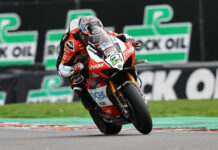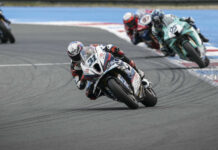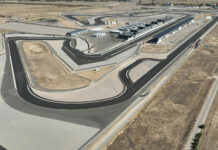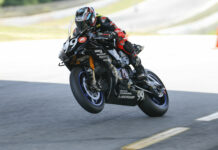IRTA has recognised the fantastic event which was the third round of the 2009 MotoGP season at Jerez, by awarding the Spanish circuit the 26th annual Best Grand Prix award. Over 120,000 fans were present at the Gran Premio bwin.com de España in May as Valentino Rossi took his first win of the season on his way to his ninth World Championship title, and the superb organisation of the event has led to the title of Best Grand Prix returning to the track. IRTA President Hervé Poncharal took great pleasure in announcing the award, and stated: “We are delighted at Jerez winning the Best Grand Prix Poll for the first time since 1990. This is one of the traditional homes of MotoGP, serving an incredible atmosphere as teams and fans gather here for the first European event of the season. “Jerez has always been a fantastic location for the Grand Prix, a great racetrack with the huge crowds giving the event a unique atmosphere, one which truly highlights the passion and excitement of MotoGP. It also has the accolade of being the longest standing of the three racetracks that make up the Spanish rounds of MotoGP. “Jerez works year on year to improve its facilities for teams and spectators alike, and since the construction of the new pit and paddock facility, first used by MotoGP in 2003, it has set a benchmark for other circuits to emulate.” Mayoress of Jerez de la Frontera and President of the Jerez Speed Circuit, Pilar Sánchez Muñoz, said: “I would like to thank the members of IRTA for awarding us with the prize as the best organisation among all the circuits that have taken part in the Grand Prix calendar during the 2009 season. “I would also like to express my appreciation to everyone involved in this organisation that has now been recognised, rewarding the work and effort undertaken by all involved. The Grand Prix of Spain 2010 is faced with renewed hope, and far from relaxing us this award is going to be a great incentive to keep improving in the future to make the Grand Prix of Spain, at Jerez, unforgettable.” More, from a press release issued by Honda: Jerez triumphs in the annual IRTA ‘Best Grand Prix’ There is no more deserving circuit than the winner of the 2009 IRTA ‘Best Grand Prix.’ A mecca for two-wheeled racing in one of the most motorcycle-friendly countries in the world, the circuit regularly hosts crowds in excess of 120,000 for one of the must-see GP’s on the MotoGP calendar. Those lucky enough to attend are bathed in sunshine at one of the most fan-friendly venues in the world, with a natural amphitheatre offering spectacular views of what is consistently some of the best racing of the year. Riders respond well to the circuit, which has been at the forefront of safety and which offers a variety of challenges along its 4.423km/13 turn ribbon of asphalt. The facitily has been constantly updated, not only for the riders, but also for the teams, the fans, and the media. The circuit’s commitment to excellence is unquestioned. It is for those reasons that the honor of the 26th annual recipient of the IRTA ‘Best Grand Prix’ returns to the Circuito de Jerez. Jerez, as its popularly known, is where many believe the MotoGP World Championship begins. Regularly the first race in the traditional European base of grand prix racing, everyone looks forward to returning to Andalucia in southern Spain after the early season flyaways. Now the riders can settle into their motor homes and the teams can work out of their semis. They are home. The circuit in the sherry country was built in 1986 and the Spanish Grand Prix first made its home there a year later. In 1988, the track played host to the Portuguese Grand Prix while the Spanish Grand Prix moved to Jarama. The Spanish GP returned to Jerez in 1989 and has remained a fixture ever since, making it among the longest continuously serving Grand Prix venues. A year later, in 1990, the track earned its first IRTA Best Grand Prix award. The consistently favorable weather makes it among the most used circuit for winter testing. It has frequently hosted the traditional IRTA pre-season test, which makes it among the most popular in the world, especially with the home riders. It is because of that popularity and constant use that the track is constantly evolving. The first major upgrade of the facility came in 1992 when a new turn was added, along with a follow-on 600m straightaway, stretching the track to its current length of 4.423 kms. for motorcycle racing. More important was the safety upgrade. Jerez became the first track to offer permanent air fence when they installed 700m of the inflatable safety barrier. The track was also repaved, as were the service ways and paddocks. The race had become so popular with the worldwide media that the press room was enlarged to hold 200 journalists. Two years later, in the summer of 1994, the circuit undertook another major transformation, adding a new chicane just before the Ferrari bend for the exclusive use of Formula One cars. Gravel traps were also enlarged to their maximum. The circuit layout has remained the same since 1996. But the track has never stopped improving. The most spectacular recent addition was the construction of the press room, a futuristic space pod that appears to be hovering over the front straight, which was undertaken during major renovations in 2003. Two years later the track was again repaved so the riders could take maximum advantage of the track’s flowing layout. Two more major changes were undertaken prior to the 2009 race. First was the reworking of the infrastructure leading to the circuit, which greatly enhanced the access to the circuit. The second was the laying of another new layer of asphalt on the racing surface. A technical track with a variety of corners, from dead stop hairpins to long sweepers, Jerez requires precision and smoothness on braking, corner entry, and with throttle control, as many of the corners are taken in second, third, and fourth gears. The turns with the hardest sustained braking, turns one and Dry Sack (turn six), are where much of the passing is done. But it’s the final looping left hand hairpin that leads onto the 600m straight which has been the site of some of the most historic passes. Who can forget Valentino Rossi’s aggressive pass of Sete Gibernau to win the race in 2005? Gibernau is but one of the great Spanish riders the country has produced over the life of the circuit, with all honing their craft at Jerez. Among the home country winners of the Spanish GP are Alberto Puig (1995), Alex Criville (1997, ’98, ’99), Sete Gibernau (2004), and, most recently, Dani Pedrosa in 2008. It isn’t only the Spaniards who excel in Jerez. Of the 11 winners, all but two had either won or would go on to win world championships. But the most prolific rider is seven-time premier class champion Valentino Rossi, a six-time premier class winner, including in 2009. “As a rule we are very strong at the track and it is always great fun riding there,” Rossi said. “I love Jerez. It’s always a brilliant atmosphere and the fans make a big, big party for three days.” His teammate Jorge Lorenzo, another homegrown product, agrees. “I think that Jerez is maybe one of the most special circuits in the world,” he said. “To be a MotoGP rider there is like a dream, all the people surrounding you.” IRTA President Herve Poncharal has the honor of announcing the award. “We are delighted at Jerez winning the Best Grand Prix Poll for the first time since 1990. This is one of the traditional homes of MotoGP, serving an incredible atmosphere as teams and fans gather here for the first European event of the season. “Jerez has always been a fantastic location for the Grand Prix, a great racetrack with the huge crowds giving the event a unique atmosphere, one which truly highlights the passion and excitement of MotoGP. It also has the accolade of being the longest standing of the three racetracks that make up the Spanish rounds of MotoGP. “Jerez works year on year to improve it’s facilities for teams and spectators alike, and since the construction of the new pit and paddock facility, first used by MotoGP in 2003, it has set a benchmark for other circuits to emulate. The summer of 2008 saw the completion of the new road infrastructure leading to the circuit, which highlights the attention the circuit and local government has paid to all aspects relating to the Grand Prix and not just those within the confines of the circuit itself. “In addition to the great facilities and atmosphere, Jerez has a long standing and loyal staff that always make our visit to Andalucia a pleasurable one. Whether we are here for the Grand Prix or for testing, the circuits’ staff have always paid the utmost attention to our needs, and along with our congratulations on winning this award we would like to offer special thanks to Juan Alvarez, Jose Ramon Garcia, Maria Escribano, Pablo Fernandez, Alfredo Franco and Raul Zarzuela for all the hard work they have put in over the years” “As Mayoress and president of the Jerez Speed Circuit, I would like to thank the members of IRTA having awarded us with the prize to the best organization among all the circuits that have taken part of the Grand Prix calendar last season 2009,” said Pilar Sánchez Muñoz, the Mayoress of Jerez de la Frontera. “From this Presidency, I would also like to express my appreciation to everyone involved in this organization that now is recognized, rewarding the work and effort undertaken from all agencies involved in the development of the Grand Prix in Jerez, prevailing constant improvement of infrastructure, both; competition for the drivers and those focused on fans, specially the approaches to the circuit and car parks, as well as security measures taken in the city. “The Grand Prix of Spain 2010 is faced with renewed hopes, with the attraction of this recognition as a reward that far from relaxing ourselves, is going to be a great incentive to keep improving in the future everything in our hands to make the Grand Prix Spain, in Jerez, unforgettable.” Event sponsor bwin.com enters its seventh season of sponsorship as one of MotoGP’s strongest supporters. The world leader in online gaming will again be the title sponsor of the races in Jerez and Estoril. Bwin.com also sponsors a corner and bridge in Brno and Misano. Circuito de Jerez Location: Jerez de la Frontera, Spain Opened: April 1987 Pole position: Left Circuit Length: 4423 m Straight: 600 m Track width: 11 m Lefthanders: 5 Righthanders: 8 IRTA Trophy Roll of Honour. 1984: Silverstone / GB. 1985: Hockenheim / Germany. 1986: Nurburgring / Germany. 1987: Assen / Netherlands. 1988: Suzuka / Japan. 1989: Donington Park / GB. 1990: Jerez / Spain. 1991: Donington Park / GB. 1992: Catalunya / Spain. 1993: Eastern Creek / Australia. 1994: Eastern Creek / Australia. 1995: Mugello / Italy. 1996: Mugello / Italy. 1997: Mugello / Italy. 1998: Phillip Island / Australia. 1999: Brno / Czech Republic. 2000: Mugello / Italy. 2001: Catalunya / Spain. 2002: Valencia / Spain. 2003: Valencia / Spain. 2004: Brno / Czech Republic. 2005: Valencia / Spain. 2006: Catalunya / Spain. 2007: Brno / Czech Republic. 2008: Losail / Qatar. 2009: Jerez/Spain.
Jerez Gets IRTA’s “Best Grand Prix” Award For 2009
Jerez Gets IRTA’s “Best Grand Prix” Award For 2009
© 2010, Roadracing World Publishing, Inc.






